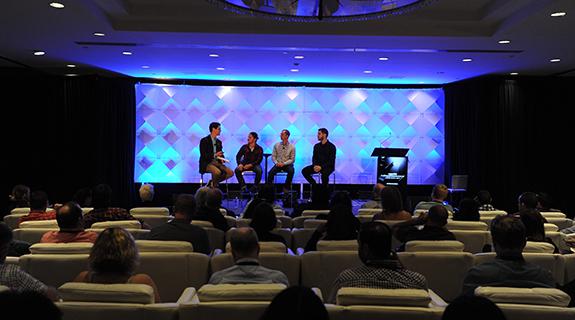Handheld devices such as iPhones, GoPros, as well as drones, are quickly emerging as professional alternatives to often cumbersome high-quality cameras.
That’s according to Phoning It In creator Mike Castellucci of WFAA, Dallas-Fort Worth, wildlife photographer and filmmaker Filipe Deandrade, and freelance photographer and director Joey L. The three spoke during the session “The New Technology of Storytelling,” moderated by Andy Baker, SVP, global creative director, National Geographic Channel’s Worldwide, at PromaxBDA: The Conference 2016.
The three delved into tips and tricks to shooting high quality video with on-the-go technology that fits in a backpack, and showed their own inspiring clips along the way.
De Andrade kicked it off with the video Adapt which won National Geographic’s second annual “Wild to Inspire” competition at the Sun Valley Film Festival in 2015. The video was compiled as he traveled for a year through five countries in Africa, using a combination of footage from a GoPro, iPhone, DSLR camera and equipment that he couldn’t afford to buy, like a slow-motion camera
“So I just rented,” he said. “That’s the secret.”
Castellucci showcased his documentary Phoning It In, Life on an IPhone, about common people doing uncommon things, captured all on a common device: one iPhone.
“It’s all about planning,” he said.
Joey L. highlighted a video from his digital series Dudes with Cameras, shot entirely on a GoPro.
“My whole career I’ve been documenting my photo shoots as I’ve been doing them,” he said.
After every photo shoot, he sits around with the crew, podcast-style, to reminisce about the shoot as a friend cuts GoPro footage to go with it.
“GoPro is so versatile, I can give it to someone who has never filmed before and be like, ‘narrate and go walk around the set,’ ” he said.
Tips, Tricks and Accessories
Pairing the appropriate accessories with these devices is an important step to achieving high-quality shots.
“[The GoPro] is so small you can take it anywhere, but because it’s so small you also get a lot of hand shake,” Joey L. said.
He recommends attaching a Gimbal, which is basically a handheld-pivoted support used to stabilize the camera while filming.
Castellucci suggested a Reti Cam mount for an iPhone, which is perfect for attaching a small tripod, and also finds a lot of value in using a small shotgun mic.
“It’s interesting the accessories are disrupting and evolving so much,” Baker said. “The phone itself is not the technology, it’s what we do with it.”
De Andrade offered a warning about being aware of audio, a lesson he learned while hiking the Appalachian Trail with his GoPro in a waterproof case. Four months later, when he was able to view the footage on a computer, he couldn’t hear anything because it was muffled by the case.
To conserve space, Castellucci keeps files shorts by asking interview questions, then moving on, so that video are no more than two minutes long. He can usually get all the footage he needs for a story with just 4 gigs of space.
And of course, always remember to bring lots of extra batteries.
An outdated iPhone that you care less about also makes a good ‘action cam.’
When it comes to shooting, de Andrade has three tips: Be sure to press and lock down on the subject so the iPhone doesn’t refocus as you’re shooting, bring the sunbar down just a hair, and hold the iPhone on the side with your fingers spread out to make sure they don’t get in the way of the shot.
Getting the Most out of Drones
Advances in drone technology is leading to a ton of new tools for videographers.
Joey L. used one in Iraq and Syria while shooting a documentary about Kurdish militia fighting the Islamic State.
“It gives you such a great aerial perspective on the front lines,” he said. Footage of him using the drone became part of the larger project.
When using a drone, he recommends flying at a slow pace, practicing on a cheap drone first, if possible, and using it as a survey device for large locations.
Whatever the technology, shooting high-quality video also requires technique.
“There’s cutaways, tights, mediums, wides, interesting angles, and all the elements that make up a good film, but just with a different device,” de Andrade said.
All three also found that using smaller, handheld devices often puts their subjects at ease.
That’s something Castellucci, who’s used to having a big production crew with him, noticed right away.
“When first went out with an iPhone from a big TV station, the subject was visibly underwhelmed,” he said.
But because it’s technology people are used to seeing every day, it’s easier for them to relax and not feel intimidated by a larger camera, which makes it easier to capture emotional moments. Someone may not break down in front of a giant camera balancing on your shoulders, but they might if in front of an unobtrusive iPhone.
“It doesn’t matter what technology you’re using,” Castellucci said. “It’s going to change tomorrow, so just keep that in mind and try to do emotional, engaging storytelling. That’s all anybody cares about.”
De Andrade also recommends “just getting the hell out there.”
“I can’t remember what I shot half my stuff on anymore,” he said. “But I do remember those experiences.”
Tags:













































__twocolumncontent.jpg)











